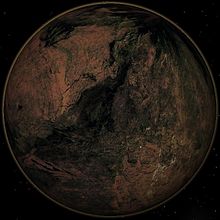
Back كوكب كربوني Arabic Karbon planeti Azerbaijani Въглеродна планета Bulgarian Planeta de carboni Catalan Kohlenstoffplanet German Planeta de carbono Spanish سیاره کربنی Persian Hiiliplaneetta Finnish Planète de carbone French כוכב לכת פחמני HE

A carbon planet is a hypothetical type of planet that contains more carbon than oxygen.[1] Carbon is the fourth most abundant element in the universe by mass after hydrogen, helium, and oxygen.
Marc Kuchner and Sara Seager coined the term "carbon planet" in 2005 and investigated such planets following the suggestion of Katharina Lodders that Jupiter formed from a carbon-rich core.[2] Prior investigations of planets with high carbon-to-oxygen ratios include Fegley & Cameron 1987.[3] Carbon planets could form if protoplanetary discs are carbon-rich and oxygen-poor. They would develop differently from Earth, Mars, and Venus, which are composed mostly of silicon–oxygen compounds. Different planetary systems have different carbon-to-oxygen ratios, with the Solar System's terrestrial planets closer to being "oxygen planets" with C/O molar ratio of 0.55.[4] In 2020, survey of the 249 nearby solar analog stars found 12% of stars have C/O ratios above 0.65, making them candidates for the carbon-rich planetary systems.[5] The exoplanet 55 Cancri e, orbiting a host star with C/O molar ratio of 0.78,[6] is a possible example of a carbon planet.
- ^ Kuchner, Marc J.; Seager, S. (2005). "Extrasolar Carbon Planets". arXiv:astro-ph/0504214.
- ^ Lodders, Katharina (2004). "Jupiter Formed with More Tar than heat" (PDF). The Astrophysical Journal. 611 (1): 587–597. Bibcode:2004ApJ...611..587L. doi:10.1086/421970. S2CID 59361587.
- ^ Fegley, Bruce Jr.; Cameron, A. G. W. (April 1987). "A vaporization model for iron/silicate fractionation in the Mercury protoplanet" (PDF). Earth and Planetary Science Letters. 82 (3–4): 207–222. Bibcode:1987E&PSL..82..207F. CiteSeerX 10.1.1.667.7941. doi:10.1016/0012-821X(87)90196-8.
- ^ P. E. Nissen, The carbon-to-oxygen ratio in stars with planets
- ^ Stonkutė, E.; Chorniy, Y.; Tautvaišienė, G.; Drazdauskas, A.; Minkevičiūtė, R.; Mikolaitis, Š.; Kjeldsen, H.; Essen, C. von; Pakštienė, E.; Bagdonas, V. (2020). "High-resolution Spectroscopic Study of Dwarf Stars in the Northern Sky: Lithium, Carbon, and Oxygen Abundances". The Astronomical Journal. 159 (3): 90. arXiv:2002.05555. Bibcode:2020AJ....159...90S. doi:10.3847/1538-3881/ab6a19. S2CID 211096705.
- ^ Teske, Johanna K.; Cunha, Katia; Schuler, Simon C.; Griffith, Caitlin A.; Smith, Verne V. (2013). "Carbon and Oxygen Abundances in Cool Metal-Rich Exoplanet Hosts: A Case Study of the C/O Ratio of 55 Cancri". The Astrophysical Journal. 778 (2): 132. arXiv:1309.6032. Bibcode:2013ApJ...778..132T. doi:10.1088/0004-637X/778/2/132. S2CID 119291907.